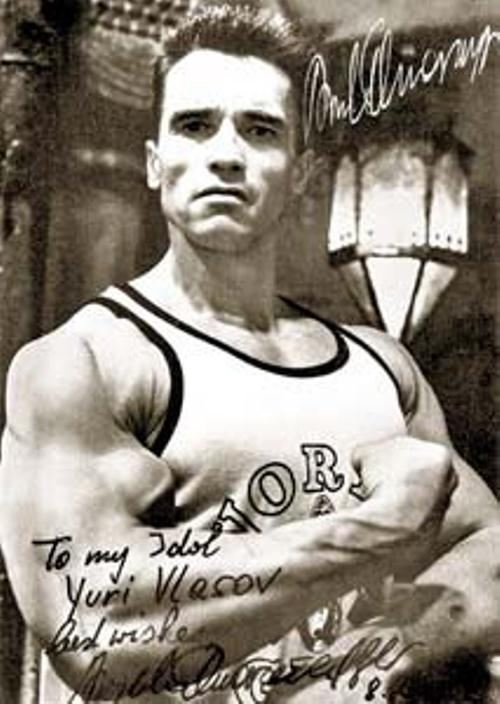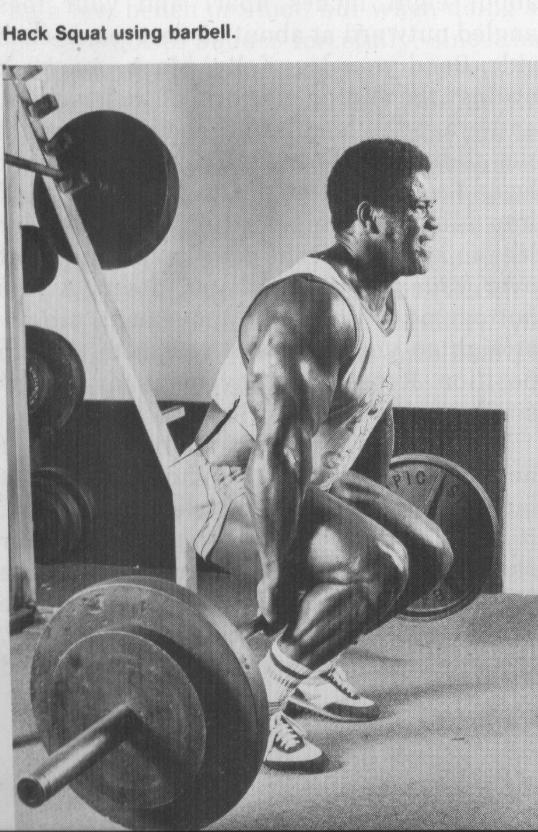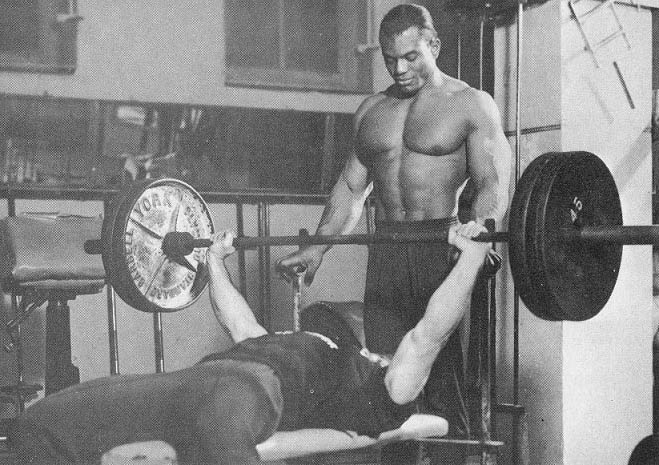In our last issue, Vince Gironda, one of the world's foremost bodybuilding authorities, was interviewed by Joe Weider and his astute, in-depth observations concerning the Nautilus machines were published. A few of his comments were, ". . . The basic mechanical concept is erroneous!" And, "This is like self-inflicted torture . . !" Also, ". . . It does not, it cannot and it will not replace conventional exercise equipment . . ."
We left off where Joe Weider had commented on the Nautilus' inability to be versatile enough to exactly
duplicate
or almost completely approximate
actual movements performed during sports activities where it would be of appreciable value as a supplemental training aid. Vince Gironda agreed, and then elaborated further on this important point when space forced us to interrupt his interview. We now continue at this point:
Vince Gironda (VG): I'll have to agree with you completely, Joe. It amazes me, too. It really baffles me; the only thing I can say is that so many gym instructors, coaches and trainers are ignorant of these facts, and aside from a few basic exercises they give their students, they are basically acting as "social directors." Joe, for many years you and I have worked with these principles and have personally instructed and seen so many athletes dramatically excel at their craft by using these valuable principles or supplemental sports training with conventional barbell equipment.
Joe Weider (JW): Right! And there's absolutely no excuse for this ignorance! Everyone should remember how fantastic athletes such as C.J. Yang and Rafer Johnson, decathlon record holders, Perry O'Brien, Dallas Long and Jay Sylvester, world record holders, developed their sports proficiency - with sensible and specialized weight-training, of course! Also, take Tommy Mason, all-pro footballer, Rod Milburn, record holding hurdler, Bob Seagren, champion pole-vaulter, Al Feuerbach, current shot-put record holder, etc. The sensible weight-trained athletes of the past and present are undeniable proof that the versatility of barbells, dumbbells and pulleys is the best. These men became outstanding champions after introducing this form of supplemental exercise to their sports training program.
VG: Very true, Joe. They got more done with more versatile equipment . . . and at less cost for this equipment, as opposed to limited, complicated, and very expensive equipment that "looked impressive." Nautilus is very much like having a big, shiny and expensive Rolls Royce that can only go down good highways with any degree of efficiency, and has to tread softly on rutted roads and steep hills, as opposed to the strong, rugged Jeep that can go anywhere, do so many things easily and efficiently . . . and it is very expensive.
JW: Precisely, Vince. It really makes you wonder, doesn't it? What about this, Vince. Take a group of people, for instance, that you wanted to run through a series of exercises in "assembly line" fashion for convenience. Just what do you think of the Nautilus machines for this type of conventional mass exercise sessions? Schools, the military, prisons, public and private institutions are almost always looking for quick, convenient and effective methods to introduce exercise to large numbers of persons and groups with less supervision.
VG: Yes, let's face it, Joe. If you
have to run large numbers of people through this type of "assembly line" training, to eliminate individual instruction, you first need something practical to do this with that embodies sound exercise principles. The hitch here is that many of the Nautilus machines aren't mechanically sound for most people's physiology. I'll tell you why. You already know how it affected big Arnold and Franco: it tore Arnold's pec and gave him painful tennis elbow, etc. I get letters telling me all the time how these people have to get cortisone shots in their shoulders after having used the Nautilus pullover machine for a time. This machine dictates compulsory arm positioning that is very unnatural and dangerous to the shoulder joint. And this isn't just a problem with neophytes - well-trained men write me debunking this contraption! I really feel sorry for the unwary person who is suckered into using it.
JW: That is one of the most common complaints I've heard - it isn't safe, and it can actually be dangerous.
VG: It sure is. Joe, let me say something else about the Nautilus pullover machine since we're talking about it. The "pullover" exercise that is performed on it is
not a good lat exercise. All it does is bring out a faint ribbon in front of the latissimus, but it builds no thickness across the back. It does work the serratus magnus, but so do so many other exercises, such as this exercise. (Here Vince jumped up and went over to a chinning bar attached to a ceiling beam where he lithely jumped up to grasp it and hang motionless for a moment. He then promptly raised his whole body out into a horizontal bar "lever" and held it solidly while talking to me! This robust man of 56 years of age is simple remarkable.)
This is
just one of the exercises I give for the lats and serratus magnus - and this bar cost me about five dollars! (He then lowered his rigid body very slowly, enjoying every second of it, dropped from the bar and returned to his desk.) There are innumerable exercises for these muscles that certainly don't require equipment costing hundreds and hundreds of dollars.
JW: That's so right. Can you think of anything else concerning the Nautilus, Vince?
VG: I'm going to say something that will completely bury anything anyone has to say in favor of the Nautilus machines as far as bodybuilding is concerned.
Who has it ever produced? Show me one man the Nautilus equipment and system of exercise has
actually produced and where it is definitely responsible for his tremendous bodybuilding development. JUST ONE!
JW: I hear Arthur Jones wants to take credit for Casey Viator's development, even though Casey was a popular and well-built bodybuilder long before Jones got him to strap himself into a Nautilus machine.
VG: Right. And I think Casey's physique has suffered as a result, even though Casey liked to do other conventional barbell and dumbbell exercises on the side. Oh, that brings up another interesting point. Arthur Jones says, "Throw away all your conventional exercise equipment!" Why, then, does he
use conventional equipment?
JW: I've heard that he says use conventional equipment
in conjunction with his Nautilus machines.
VG: Arthur Jones has told me many times - he used to call me on the phone from Florida and talk for two or three hours at a time, several times a week - and he'd tell me, "Throw your conventional equipment away, you don't need it anymore." Period! Just look at his machines. He has conventional devices hanging on his apparatus now. For instance, to do chins to pump up before or after using his machine, etc.
Now let's take his so-called "new concept" in exercise equipment. All he's done is taken a lot of ideas that were already here and being put into practice. Certainly nothing too scientific, or even dramatic. There have been, in the past, many types of strange, odd, impractical and overly complicated pieces of bodybuilding equipment for us bodybuilders to choose from. What was salvaged from this innumerable assortment of is what we have proved through endless application in bodybuilding and use today. These are the ones that have proved themselves to be of benefit - the ones that produced
results. Some of the lousy ones hung on longer than should they should have and are still being used by a few uninformed persons, but in general they are neglected and eventually junked, because they have no practical value. Bodybuilders want and need
only the best - and will
not settle for less.
At this time, Joe, I want to make one point understood: I am not knocking Arthur Jones as a person - in fact he's a good friend of mine, and has been for some time. I am only scientifically evaluating his equipment and methods as I see them.
JW: Sure, I realize this, Vince. That is both honest and healthy - and much more of this in-depth investigation, evaluation and critique should be entered into in the physical fitness field by qualified and concerned parties in order to more fully evaluate the principles, knowledge and ideals - every contribution - of all persons involved.
VG: In this vein, Joe; in the beginning I actually endorsed Arthur Jones contribution to bodybuilding because he introduced - rather
injected - energy into this business. He offered something
new. He demonstrated the daring ability to be different . . . creative . . . even revolutionary! I admired this in the man. His new concepts caused a lot of people to work harder, think harder, etc. This sort of stimulus
always offers nourishment for the journey along the road to man's progress.
JW: History is full of forceful, dynamic persons -definite individuals - who have, through their highly irregular contributions, caused enormous and dramatic changes in the world. Euclid, Plato, Edison, Einstein, Salk, etc., contributed badly-needed medicinal, social and scientific breakthroughs; and Genghis Khan, Hitler, Stalin, etc., contributed destructive, wicked and warring influences that caused nauseating carnage. Both types of influence have to be recognized in proportion to what they offered - and caused to happen - and
then what was eventually done to either accept or eradicate the effects of their influence upon the world. I believe we are doing this right now . . . and I also think that bodybuilding will eventually profit immensely from such investigations as we are presenting in these interviews. This Nautilus thing sort of reminds me of Aristotle's powerful influence upon the world when his philosophical and distorted ideas about matter were innocently accepted and
believed for centuries before other thinking, inquiring and inventive men proved otherwise . . . and humanity once again began to progress.
VG: Man has always done this. There are only a few who concentrate on the real facts of life and don't distort them. Man, in general, often looks to the dramatic side of things which
seem to offer what he wants, when what he actually
needs are things that are simple, uncomplicated, and lack garish color. Man gets bored easily, and this boredom, if unchecked, can cause him to look beyond his normal hum-drum existence for something that stimulates his life. And far too often this emotional search distorts his true perspective and limits his ability to possess a sense of penetrating analysis concerning his true needs . . . Exotic and unnatural methods of bodybuilding, for instance, can replace sensible conventional methods for a time 'til the novelty wears off, but then it's right back to the tried-and-true methods once again.
JW: Oftentimes ideas and items that are only available as novelties are presented as earth-shattering breakthroughs in a given field, and then they erupt on the scene as marvels of performance in the field, supposedly possessing intrinsic value. This is due entirely to the dynamic selling force and gall of its promoters. But, so often, this thing's ability to exist as an entertaining novelty only conceals its real worth, and also hides the true value of other basic, conservative and productive items. This dramatic camouflage actually lures otherwise thinking persons into a pseudo-intellectual fog, and before they reason their way out of it, perhaps years of wasteful and nonproductive effort has dissipated their energies. This isn't progress, it's exactly the opposite.
VG: This is what happened years ago when inquisitive bodybuilders pioneered this field. They were very interested, and even devoted to obtaining health, strength and big muscles; and as a result investigated
every type of diet, exercise, piece of equipment, method, etc. The result of this inquiry into the new field of bodybuilding, individually and collectively, has caused enormous strides of advancement in the artistic and scientific aspects of bodybuilding and sports. Nutritionists, physiologists, therapists, etc., learned from them - their newly-proved physical results in this field that were unknown before. It didn't start the other way around.
Let's take the chemical sciences, for instance. The amateur investigator of the physical world of the past - called alchemists - were stimulated into an energetic, untiring, greedy and well-documented search for the secret with which to manufacture gold from base elements . . . and this caused our science of chemistry to be realized. It didn't start with scientific concepts; it was developed from accumulated facts. The same is true with bodybuilding. The scientific approach is to take knowledge - known and/or suspected facts - then engineer or weave these into a controlled blend of happenings that do the desired job. Experience
first, then the progressive variations follow to further enhance it. The scientist (the instructor, teacher, equipment designer, coach, etc.) has to
know the real facts before successful experiments will follow.
JW: When something is "tested" in order to determine its merits, a number of relevant and intelligent considerations of the initial and supporting facts are necessary . . . and are very important if the true measure of the thing's general or specific purpose and function is desired. These considerations must be understood and entered into only by qualified researchers lest the experiments, in reality become
failures even while they are being disproportionately praised as successes. True scientists fully realize that the results of their experiments are completely dependent upon their own knowledge of the ingredients they are working with, and their consideration of the "unknown" factors involved. True scientists and researchers also appreciate the separate meanings of the words
theory, theorem, and
fact - and do not confuse one with the other. It is a
theory that the Nautilus machines can be a productive bodybuilding/sports training aid. Its whole principle and resulting mechanical design should be the result of a number of supporting
facts concerning anatomy, physiology and exercise methods, etc., in careful and intelligent combination. It is a
theorem that the Nautilus is being proposed and/or accepted as a demonstrable truth in this respect. In other words, its usage should prove-out its theory. Theory has to be conclusively demonstrated in connection with its claims before it can even hope to be considered as, and eventually recognized as, a
fact. A
fact that Arthur Jones' Nautilus machines, method of exercise, and what he claims for both of them, is not factual in theory or demonstration - in
fact, the reverse is usually true.
Here's an interesting parallel - a brand-name cola, made from artificial flavorings and coloring, is breaking all records for sales in supermarkets and vending machines. The company manufacturing it is predictably thrilled,as are the stockholders, over the cola's meteoric rise in sales. There is no doubt whatsoever that it is a marvelous
success - commercially; but as far as human nutrition is concerned, it is a
total failure. This cola is not necessary, it is a novelty. It offers nothing of importance, only an attractive can, exiting taste and feebly quenches the thirst, and perhaps a catchy advertising jingle. But it does require money to purchase it . . . and sometimes it is even harmful to the consumer.
The Nautilus machines are not necessary, they are a novelty. They offer nothing of importance, only an attractive and interesting design. When first trying their 'taste,' there is an interesting newness that only feebly quenches one's thirst for results, and their advertising 'jingle' is certainly catchy . . . but do they take money - lots of it! - to purchase.
VG: Very true, Joe. Their novelty value, in relation to their obvious lack of bodybuilding value, is causing a lot of us to be concerned - even agitated - however, it is stimulating the world of bodybuilding into action and thought, and hopefully reform. Stimulating the mind to
think is of great importance to us all.
JW: Do you think there's any room for improvement on Jones' Nautilus machines? I mean by this, improvement without altering them too much since this would tend to change these machines to a point where they would no longer be Nautilus machines.
VG: If he wanted to be scientific about it, he would follow the muscle physiology throughout its complete extension and contraction, as well as consider the many
compound functions the muscles have in their job of moving and rearranging the skeleton. It is a vastly complex variety of movements, not
isolation of movements. This variety of natural movement is where
thorough muscle development takes place, and where conventional exercise equipment reigns supreme.
JW: There is just no real comparison.
VG: The Nautilus machines do not develop the body thoroughly or safely as does conventional equipment. Barbells, dumbbells, pulleys, combined with the various conventional and specialized exercise benches, chinning and dipping bars are the best pieces of exercise equipment available today, and there's no exception. So far, especially where the Nautilus machines are concerned, nothing can compete with this sensible stuff we use today - the stuff that is turning out all the thousands of well-built men all over the world. Just look at the top Mr. Americas on through the other Mr.'s up to the greatest, the Mr. Olympias. They are
all products of our conventional bodybuilding equipment.
If these Nautilus machines can do it alone, don't just talk about it . . .
SHOW ME!





















